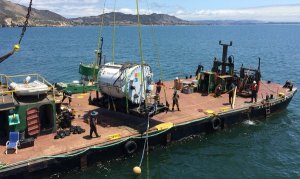
Under the Sea
Researchers from Microsoft are testing a prototype of a self-contained data center that is capable of running and operating hundreds of feet under the sea.
The move could prove to be a solution to one of the most common problems that computer servers face today—overheating, which then causes the servers to crash. It could also potentially address another growing concern that stems from the rising energy demand of computing technology, as Microsoft looks into pairing the system with turbines or tidal energy to generate the electricity needed.
The project has been code-named Project Natick and could see the construction of fiber optic cables on the sea floor. Other possible systems could see suspended containers under the sea to capture ocean current with turbines in order to generate electricity.
Project Natick
“When I first heard about this I thought, ‘Water … electricity, why would you do that?’ ” said Ben Cutler, a Microsoft computer designer and engineer working on the Project Natick system. “But as you think more about it, it actually makes a lot of sense.”
The underwater data center could face a lot of challenges, including environmental concerns and unforseen technical issues that, given its location, would make it very difficult to address quickly.
But Microsoft believes that this radical move could shorten deployment time of new data centers from two years to 90 days, offer a huge cost advantage, and help make web services run faster by having the ability to place computing resources near users instead of geographically out-of-the-way locations.
To monitor and prevent hardware failures and leaks, the system, which recently completed a 105-day trial under 30 feet of water in the Pacific Ocean, was outfitted with a hundred sensors designed to measure pressure, humidity, motion and other conditions.
The prototype steel capsule proved to be a success and and has since been returned to Microsoft’s corporate campus.

Currently, the research group is busy designing another system that will be larger with longer trials expected to begin by next year.
But soon, underwater computing may kind of be a reality.